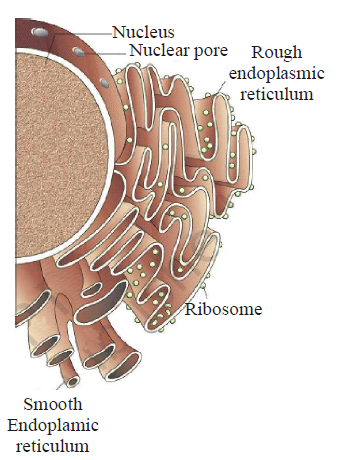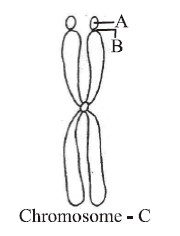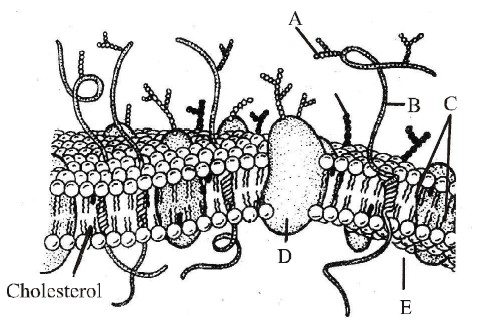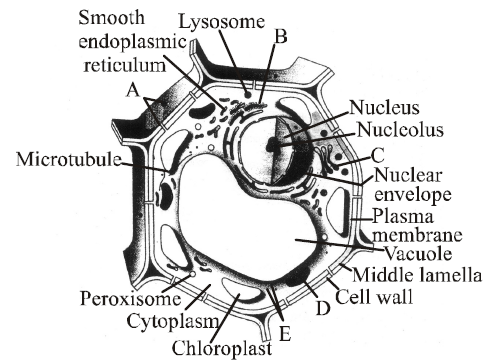Match column-I with column-II and choose the correct option.
| Column-I | Column-II |
|---|---|
| (Chromosome) | (Position of Centromere) |
| A. Metacentric | I. At the tip |
| B. Submetacentric | II. Almost near the tip |
| C. Acrocentric | III. At the middle |
| D. Telocentric | IV. Slightly away from the middle |
A III; B IV; C II; D I
A IV; B III; C II; D I
A I; B II; C III; D IV
A IV; B III; C I ; D II
Correct Answer :
A. A III; B IV; C II; D I
Metacentric chromosomes have the centromere in the centre, such that both sections are of equal length. Human chromosome 1 and 3 are metacentric. Sub metacentric chromosomes are a chromosome with the centromere so placed that it divides the chromosome into two arms of strikingly unequal length. Acrocentric chromosomes have a centromere which is located almost near the tip leading to one very long and one very short section. Human chromosomes 13, 15, 21, and 22 are acrocentric. Telocentric chromosomes have centromere which is located at the terminal end. Telomeres may extend from both ends of the chromosome. Humans do not possess telocentric chromosomes.
Related Questions
Which one of the following organelle given below is correctly matched with its function ?

Golgi apparatus Protein synthesis
Golgi apparatus Formation of glycolipids
Rough endoplasmic reticulum Protein synthesis
Rough endoplasmic reticulum Formation of glycoproteins
Plastids are found in
all animal cells.
some animal cells.
all plant cells.
all plant cells and euglenoides.
Which of the following cell organelles were discovered after the introduction of electron microscope?
Mitochondria
Endoplasmic reticulum
Ribosomes
Both (b) and (c)
Which of the following organelles is directly connected to the outer membrane of the nucleus in a eukaryotic cell?
Mitochondrion
Lysosome
Golgi apparatus
Endoplasmic reticulum
The cell theory was given in year 1839 by Schleiden and Schwann. According to this theory all organisms are composed of cell and cells are the basic unit of life.
How did this theory help in the field of science?
It helped to study the working of cells.
It helped in curing diseases caused by cell.
It helped in restating the earlier theories on cell.
It helped in introducing the use of microscopes to study cell.
An organalle devoid of membrane covering is
vacuole
ribosome
peroxisome
lysosome
_______________ is the important site of formation of glycoproteins and golycolipids.
SER
Lysosome
Golgi apparatus
Mitochondria
Protein synthesis in an animal cell occurs
on ribosomes present in cytoplasm as well as in mitochondria.
on ribosomes present in the nucleolus as well as in cytoplasm.
only on ribosomes attached to the nuclears envelope and endoplasmic reticulum.
only on the ribosomes present in cytosol.
Select the correct match of the types of neuron present in column I with its location given in column II.
| Column I | Column II |
|---|---|
| A. Centrioles | (i) Non-membrane bound organelle which helps in cell division |
| B. Fimbriae | (ii) Special structure of bacteria which help them to attach with rocks in stream and also to host tissue |
| C. Endomembrane | (iii) Includes those organelles system whose functions are coordinated |
| D. Mitochondria | (iv) Divide by fission and site of aerobic respiration |
A - (i), B - (ii), C - (iii), D - (iv)
A - (iii), B - (i), C - (ii), D - (iv)
A - (iii), B - (i), C - (iv), D - (ii)
A - (i), B - (iv), C - (iii), D - (ii)
Which of the following statements are correct?
Na+/K+ pump is an example of active transport.
In plant cells lipid like steroidal hormones are synthesized in SER.
In plant cells, the vacuoles can occupy up to 10% of the volume of the cell.
Chlorophyll and leucoplast are responsible for trapping light energy essential for photosynthesis.
According to widely accepted fluid mosaic model cell membranes are semi-fluid, where lipids and integral proteins can diffuse randomly. In recent years, this model has been modified in several respects. In this regard, which of the following statements is incorrect?
Proteins in cell membranes can travel within the lipid bilayer.
Proteins can also undergo flip-flop movements in the lipid bilayer.
Proteins can remain confined within certain domains of the membrane.
Many proteins remain completely embedded within the lipid bilayer.
Which of the following pair are correctly matched ?
(I) Amyloplasts Store proteins
(II) Mitochondrion Power house of the cell
(III) Stroma Chlorophyll pigment
(IV) Axoneme 9 + 2 array
(I) and (III) only
(II), (III) and (IV) only
(III) and (IV) only
(II) and (IV) only
The following diagram represents a structure chromosome.
Identify the structures marked as A, B and C.

A - Satellite, B - Primary constriction, C - Acrocentric
A - Satellite, B - Secondary constriction, C - Metacentric
A - Satellite, B - Centromere, C - Telocentric
A - Satellite, B - Centromere, C - Submetacentric
pH of vacuolar cell sap is
neutral and isotonic.
alkaline and isotonic.
acidic and hypertonic.
equal to cytoplasm and isotonic.
In which method of transport, plasma membrane does not require carrier molecule?
Active transport
Facilitated diffusion
Simple diffusion
Na+ K+ pump
Match the items given in column-I with their role given in column-II and choose the correct option.
| Column-I | Column-II |
|---|---|
| A. SER | I. Increase the surface area |
| B. Golgi apparatus | II. Store oils or fats |
| C. Cristae | III. Excretion |
| D. Peroxisome | IV. Photorespiration |
| E. Elaioplasts | V. Synthesis of lipid |
A V; B III; C I; D IV; E II
A V; B III: C II; D IV; E I
A II; B III; C I; D IV; E V
A III; B IV; C I; D V; E II
Which one of the following combination is mismatched?
Glycocalyx May be capsule or slime layer
Pili Reproduction
Cell wall Protective, determines shape, prevents from bursting
Flagella, pili and fimbriae Surface structures of bacterial cell
Which of the following pair lack the unit membrane?
Nucleus and E.R.
Mitochondria and chloroplast
Ribosome and nucleolus
Golgi body and lysosome
Select the statements which are related to Schwann.
- He reported that cells have a thin outer layer which is today known as plasma membrane
- Cell wall is a unique character of the plant cell.
- Body of plants and animals are composed of cells and products of cells.
Only (i)
Only (iii)
(i) and (iii)
All of these
8.A student was given cell samples (A and B) to identify parts which are highlighted. He observed the samples under the microscope and list down the function of the part of cell sample. The information collected by the student is listed in the table below, on the basis of which the student infers that the samples contain the organelles.
| Sample A | Sample B |
|---|---|
| Make energy available for cellular metabolism | Generates ATP and synthes izes s ugar |
| Absent in cell that carry oxygen throughout the body | Present in plant cell |
| Called the energy currency of cell | Source o f all the food energy |
Identify the part highlighted in the sample A and B and explain why they were called as semi-autonomous organelles?
Sample A - Mitochondria, Sample B - Chloroplast; because both the organelles are double membrane bound structure.
Sample A- Mitochondria, Sample B - Chloroplast; because they both are capable of synthesis of their own proteins only.
Sample A - Mitochondria, Sample B - Chloroplast; because they are capable of synthesis of their own proteins and contain their own DNA.
Sample A- Mitochondria, Sample B - Chloroplast; because they contain their own DNA to transfer the genetic information from one generation to another.
Match column-I (scientists) with column-II (discovery) and select the correct option.
| Column-I | Column-II |
|---|---|
| A. Leeuwenhoek | I. First saw and described a living cell |
| B. Robert Brown | II. Presence of cell wall is unique to plant cells |
| C. Schleiden | III. Discovered the nucleus |
| D. Schwann | IV. All plants are composed of different kind of cells |
A I, B III, C IV, D II
A I, B III, C II, D IV
A III, B I, C IV, D II
A I, B IV, C II, D III
The lipid component of the membrane mainly consists of __________.
polysaccharides
phosphoglyceride
monosaccharaides
both (a) and (c)
The diagram given below represent a filuid mosaic model of plasma membrance. Match the components marked as A, B, C, D and E in the diagram below from the list (i) to (vii).

- Sugar
- Protein
- Lipid bilayer
- Integral protein
- Cytoplasm
- Cell wall
- External protein
A - (i), B - (ii), C - (iii), D - (iv), E - (v)
A - (ii), B - (i), C - (iii), D - (iv), E - (v)
A - (i), B - (ii), C - (iii), D - (iv), E - (vi)
A - (i), B - (ii), C - (iii), D - (vii), E - (v)
Match column-I with column-II and select the correct option.
| Column - I | Column - II |
|---|---|
| A. RER | I. Intracellular and extracellular digestion |
| B. Cell wall | II. Provide structural support to the cell |
| C. Flagella | III. Protein synthesis and secretion |
| D. Lysosomes | IV Responsible for cell movement |
A III, B II, C IV, D I
A II, B III, C IV, D I
A I, B III, C II, D IV
A IV, B II, C III, D I
In prokaryotes, chromatophores are
specialized granules responsible for colouration of cells
structures responsible for organizing the shape of the organism.
inclusion bodies lying free inside the cells for carrying out various metabolic activities.
internal membrane system which becomes extensive and complex in photosynthetic bacteria.
Who proposed the theory that Cells arise only from the pre-existing cells?
Mohl
Virchow
Haeckel
Brown
The following diagram shows some of the missing structures in a plant cell marked as A, B, C, D E. Choose the option with their correct names.

A - Plasmodesmata, B - Rough endoplasmic reticulum, C - Golgi apparatus, D - Mitochondrion, E - Ribosomes
A - Desmosome, B - Rough endoplasmic reticulum, C - Golgi apparatus, D - Mitochondrion, E - Ribosomes
A - Plasmodesmata, B - Smooth endoplasmic reticulum, C - Golgi apparatus, D - Mitochondrion, E - Ribosomes
A - Tight junction, B - Rough endoplasmic reticulum, C - Golgi apparatus, D - Mitochondrion, E -Ribosomes
Which one of the following is not considered as part of the endomembrane system?
Golgi complex
Peroxisome
Vacuole
Lysosome
Which one of the following cellular parts is correctly matched with their characters ?
Centrioles Sites for active RNA synthesis.
Lysosomes Optimally active at a pH of about 8.5.
Thylakoids Flattened membranous sacs forming the grana of chloroplasts.
Ribosomes Those on chloroplasts are larger (80S) while those in the cytoplasm are smaller (70S).
Which of the following is incorrect ?
Mycoplasma is the smallest cell (0.3 �).
Bacteria are 3 to 5 �m in size.
The largest cell is the egg of an ostrich.
Nerve cells are some of the smallest cells.
